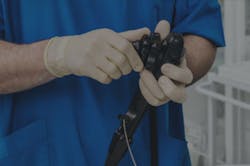What are the myths versus the truths when it comes to SPD staff comprehending and implementing manufacturer instructions-for-use to reprocess medical/surgical devices?
Most pressing IFU myths
One of the lingering and troublesome myths regarding endoscopes of all types is that scopes should not be immersed in water during the cleaning process. We have met SPD staff members who continue to believe that submersing a scope, whether a rigid or flexible type, in enzymatic solution or rinse water will actually cause the scope to leak. Instead, they will simply wipe off the endoscope with a towel or perhaps a sponge soaked in enzymatic solution, followed by a quick rinse under running water. This alternative, however, results in potentially inadequate cleaning.
Endoscopes must be water tight. A leaking endoscope is not safe for patient use because it cannot be cleaned/disinfected or sterilized effectively. Unless immersion of the scope has been prohibited in the OEM’s instructions for use, this step should always be performed when cleaning and rinsing the endoscope.
In addition, there also appears to be a persistent myth among SPD personnel that the IFUs written by OEMs should be viewed as recommendations for care of scopes, and not the be-all and end-all of instrument care. Once again, the primary purposes in specifying the critical steps in endoscope cleaning and decontamination are to ensure patient safety and to prolong instrument life and usability. Rather than being merely a suggested action, each step in the process must be carefully followed to completion to achieve these goals.
– Crit Fisher, Director, Field Operations, Protection 1,
KARL STORZ Endoscopy-America Inc.
I hear this question a lot. Common myths are staff not following the IFUs at all, not using the right size brushes for cleaning, and not soaking for the correct amount of time at the various stages of reprocessing. This is mostly because they do not have the correct type or amount of brushes, along with not totally comprehending why the dwell time for soaking and cleaning is important. It is understanding of the importance of each step being followed that is the key.
I think the FDA has said it best in their FDA Alert on September 18, 2015. While not every medical device report contains information sufficient to definitively identify the factors contributing to persistent device contamination or device-associated infections. FDA analysis to date has identified two recurrent themes: Failure to meticulously follow the manufacturer’s instructions for reprocessing and continued use of devices despite integrity, maintenance and mechanical issues.
– Stephen Kovach, Director of Education, Healthmark Industries, Fraser, MI
Most pressing IFU truths
Cleaning and decontamination are generally considered critical processes for preventing the spread of infection and disease in healthcare settings. Each OEM has created IFUs for each device to extend the life of the product and help safeguard patients.
Today, SPD pros face a range of issues, or key truths, in performing everyday tasks. These range from current budget challenges that continue to affect many healthcare operations, to meeting new goals in terms of operational efficiency, enhancing quality of care and others. A few points to be kept in mind include:
- The absolute necessity of following every step of each device’s IFU until the very last step has been performed.
- Following IFUs to completion for endoscopic equipment (especially flexible endoscopes) can take time — there are seldom any shortcuts that do not pose added risks.
- Staff turnover can require that more time must be dedicated to education and training on SPD issues and practices.
- In addition to recognized guidelines and rules, it is important to check for specific reprocessing requirements that may have been specified in state legislation.
– Crit Fisher, Director, Field Operations, Protection 1,
KARL STORZ Endoscopy-America Inc.
One of the most overlooked, pressing truths is the importance of prompt bedside cleaning. This essential step removes the patient’s biomaterials and prevents it from hardening within the endoscope that causes biofilm. Choosing the appropriate enzymatic and following the proper procedure provided by the manufacturer is one of the most critical steps in endoscope reprocessing. This requires very close coordination with the staff involved in the case itself.
Another hard truth of an IFU is the one-hour rule. Especially in the case of dealing with ancillary or satellite sites, it is difficult to acquire the scope within one-hour time frame. If there is a delay in the scope reaching the decontamination area after bedside cleaning, soaking in an enzymatic for up to 10 hours may be required per IFU. With the shortage of scopes and patient turn-around time, this process can be very tricky, although necessary.
Leak testing is another important step that is frequently skipped or done incorrectly due to time constraints put on staff to “turn around” scopes for upcoming cases. A leak that is not detected creates an opportunity for cross contamination of equipment and presents a huge risk to patients for infection.
In some cases, there are 25-30 pages of cleaning instructions. It is very difficult to remember every step for the various scopes in the facility. When you are actively cleaning a scope, your hands are wet and soiled, so flipping through the manufactures’ instruction booklet is not an option. Even with proper training, it makes it very difficult to follow the IFU, although extremely critical.
Improper dilution of detergent is another misconception. In this case, more is not better. The enzymatic detergent is specially designed to be effective at the proper temperature and dilution per manufacturer. An alteration can cause ineffective detergent, unable to rinse properly, and possible damage to the scope.
When brushing using the cleaning brushes, technicians tend to use an upward and downward motion. This is incorrect. Because of the micro-scratches inside the scope, technicians should be using a twisting motion as well as an up and down motion. This helps the brush to penetrate the microscopic infractions within the scope channels. Select the proper diameter and length brush for the internal surface/channel to be cleaned. Using incorrect or worn out brushes is common error in cleaning departments, especially facilities with various models and manufacturers.
– Brianne Flesher, Flexible Scope Division Manager,
Mobile Instrument Service & Repair Inc., Bellefontaine, OH
Simply put, follow the IFU and you will succeed in having a clean and functional medical device. So why not do it the right way each and every time? It is that simple.
– Stephen Kovach, Director of Education, Healthmark Industries, Fraser, MI
About the Author
Rick Dana Barlow
Senior Editor
Rick Dana Barlow is Senior Editor for Healthcare Purchasing News, an Endeavor Business Media publication. He can be reached at [email protected].




